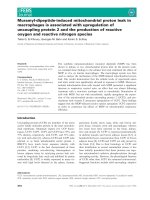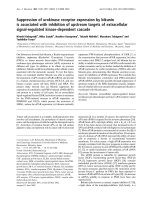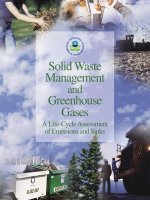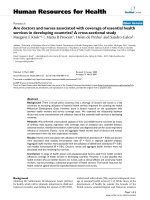Solid waste management associated with develop of 3R initiative
Bạn đang xem bản rút gọn của tài liệu. Xem và tải ngay bản đầy đủ của tài liệu tại đây (266.65 KB, 9 trang )
Abstract The purpose of this article is to describe the appli-
cation and progress of the Reduce–Reuse–Recycle (3R)
initiative and its gradual implementation and development
in solid waste management in Vietnam through the study of
the municipal solid waste management (MSWM) systems
of eight major urban cities and provinces. The resulting
survey and studies showed that there are big challenges for
MSWM in the study areas due to the absence of an appro-
priate master plan for MSWM; there is a clear need to set
up indicators for waste reduction and greenhouse gas emis-
sion reduction from waste generators and enterprises
involved in MSWM, especially in terms of using 3R activi-
ties in the management of industrial waste. The strength and
organic combination of institutional frameworks, support
measures, and technologies for 3R promotion need to be
applied as soon as possible in order to implement MSWM
practices using more effective measures; in particular, a
reduction in the amount of hazardous substances discarded
and improvements in the handling of hazardous waste are
required.
Key words 3R initiative in Vietnam · Municipal solid waste
(MSW) management · Hazardous waste · Recycling
Introduction
According to the results of the population census of April
1, 2009, the population of Vietnam was 85,789,573 persons,
distributed throughout six socioeconomic regions covering
the whole country. The rural population growth rate was
only 0.4% per year, but the urban population growth rate
was 3.4% per year.
1
In 1999, only 23.5% of the population
lived in urban areas, but in 2009 this fi gure had risen to
29.6%. In October 2009, there were 223 industrial parks
(IPs) in the country. IPs play a very important role in the
formation of a strong industrial force for economic develop-
ment in the country. In 2008, total industrial output from
industrial zones reached US$33.2 billion (accounting for
38% of GDP), of which $16.2 billion was the value of
exports, accounting for 25.8% of the country’s exports. In
addition, the IPs paid about $2.6 billion to the state budget,
creating about 1.2 million jobs.
2
Each hectare of land used
by IPs generates $1.68 million per year.
2
The purpose of this article was to introduce the progress
made in applying Reduce–Reuse–Recycle (3R) initiatives
and the gradual implementation and development of the 3R
initiative in municipal solid waste management (MSWM) in
Vietnam and to analyze the performance of MSWM and the
challenges of 3R. The implementation and development of
the 3R initiative will be based on the existing survey results
on MSWM in Hanoi and other major urban areas in
Vietnam.
Methods
Eight major urban cities and provinces (Hanoi, Haiphong,
Hue, Da Nang, and Ho Chi Minh cities and Dong Nai, Binh
Duong, Ba Ria–Vung Tau, Fig. 1) were selected as study
areas. Existing data were collected from the Statistics Year-
book of Vietnam, Healthcare Statistics Yearbook 2008,
National/Provincial Report on the Environment, and the
solid waste management (SWM) survey in Hanoi for 2008
and 2009. Surveys at landfi ll sites, interviews with city/pro-
vincial Departments of Natural Resources and Environ-
ment (DONREs), Urban Environmental Companies
(Urenco), and other related studies have been referenced.
The collective population of the target areas was
22 344 811 (April 1, 2009), accounting for 26.05% of the total
population of Vietnam. These areas included 99/223 estab-
lished Industrial Parks (IPs)
2
covering 9137 ha and account-
ing for 57%–59% of total land for IPs in the nation; the
industrial output value of the 99 IPs accounted for 63.1%
J Mater Cycles Waste Manag (2011) 13:25–33 © Springer 2011
DOI 10.1007/s10163-010-0312-y
Ngo Kim Chi · Pham Quoc Long
Solid waste management associated with the development of 3R initiatives:
case study in major urban areas of Vietnam
N.K. Chi (*) · P.Q. Long
Institute of Natural Products–Chemistry, Viet Nam Academy of
Science and Technology, 18 Hoang Quoc Viet, Cau Giay, Hanoi,
Vietnam
Tel. +84-43-7912-731; Fax +84-43-753-390
e-mail:
Received: May 16, 2010 / Accepted: September 14, 2010
SPECIAL FEATURE: ORIGINAL ARTICLE
3R International, Kyoto Workshop on 3R and Waste
Management, 2009
26
of the total national industrial output (General Statistics
Offi ce – GSO, Vietnam). The healthcare services lead
nationally, with 61 081 public beds in total, accounting for
42.76% of the total public beds throughout the central,
provincial, and district levels.
3
Results and discussion
Legal framework on solid waste management and the
3R initiative
Vietnam is now facing a worsening SWM problem, resulting
in shortages of resources and energy. These facts emphasize
the need to instigate the 3R initiative based on the 3R
model from Japan with focus on promoting 3R activities.
Such activities include cooperation and implementation
involving stakeholders, revision of the policies and regula-
tions on SWM and waste separation at source (WSS) in
order to reduce the volume of waste going to landfi ll (LF)
sites, saving and utilizing natural resources, and solving the
problem of environmental and sanitation issues related to
waste to promote public health. The Government of Vietnam
has recognized the role of the 3R initiative and considers
the 3R plan as a key factor in a successful SWM policy. The
Government confi rmed and expressed its determination to
improve SWM through properly implementing WSS, reduc-
ing the amount of waste landfi lled, and recovering valuable
materials from waste. These were all introduced in the Law
of Environmental Protection (LoE), which was amended in
2005 with 14 provisions added in order to promote 3R activ-
ities.
4
In addition, in Governmental Decree 59/2007/ND-CP,
dated April 9, 2007, the Prime Minister issued detailed regu-
lations and instructions on implementing SWM as regulated
in the LoE. WSS was referred to in Article 19 and Article
21, and these guide the recovery and reuse of the most
useful materials in waste. The roles and obligations of part-
ners and stakeholders in SWM include responsibility for
hazardous solid waste (HzSW) management, disposal, and
treatment by arrangement of color-coded waste collection
bins according to the nature of the waste, and were specifi ed
in Article 67, LoE 2005, and in Article 26 and Article 27 of
Governmental Decree 59/2007/ND-CP on SWM.
Decision 1440/2008/QD-CP of the Overall Master Plan
of SWM for three key economic regions in Vietnam pro-
poses a main policy of 3R solutions to reduce waste through-
out the WSS system. The National Strategy on Integrated
Solid Waste Management until 2025, with a vision up to the
year 2050, was approved by the Prime Minister on Decem-
ber 17, 2009.
6,7
The Prime Minister expressed the Govern-
ment’s determination to overcome the current problems in
SWM and to implement WSS. The basic principle for the
application of 3R in SWM was expressed as “Polluter pays.”
The strategy involves the simultaneous implementation of
integrated measures to prevent and reduce waste and to
increase waste recycling and reuse, thereby decreasing the
waste dumped in landfi lls. The target is to increase MSW
collection and treatment as well as to increase the percent-
age of MSW being recycled (Fig. 2). MSW collection and
treatment is targeted for 2015 as 80% of the total MSW
generated with 35% of MSW being recycled, reused, com-
posted, or having energy recovered. In 2020, these fi gures
increase to 90% of the total MSW generated with more
than 60% of MSW being recycled, reused, composted, or
Fig. 1. The study areas were located in eight major urban cities and
provinces (Hanoi, Haiphong, Hue, Da Nang, Ho Chi Minh, Ba Ria–
Vung Tau, Dong Nai, and Binh Duong)
0
20
40
60
80
100
120
2008 2015 2020 2025
% of MSW collection and treatment
% of MSW recycled, reused, energy recovered, composted
Fig. 2. Target municipal solid waste (MSW) collection rates and per-
centage of MSW recycled to the year 2025
27
having energy recovered, and then, in 2025, reaching the
collection and treatment of 100% of MSW generated, with
more than 85% being recycled, reused, composted, or
having energy recovered.
Decision No. 47/2007/QD-BYT on the regulation of
Health Care Waste Management (HCWM) has been revised
based on the conception of 3R implementation. With the
new regulation on HCWM, the categories of each type of
waste have been clearly identifi ed; the multi-solution and
technical option on Health Care Solid Waste (HCSW) treat-
ment have been introduced for use toward environmentally
friendly treatment of HCSW. Disinfection with autoclaves,
microwaves, and wet stream, and safe treatment and dis-
posal in sanitary pits or safe recycling of waste have been
introduced. Subsequently, the amount of general healthcare
waste has been gradually reduced. Throughout 2010, it has
been predicted that there will be only 25 000 tons/year of
hazardous HCSW generated nationwide from the total
planned number of public beds of 166 362.
3
The technical standards and requirements on solid waste
disposal technology have been detailed. Vietnam has issued
landfi ll technical standard TCVN 6696-2000 and TCXDVN
261: 2001 on domestic landfi ll waste design and require-
ments. TCVN 6706: 2000 and TCXDVN 320: 2004 cover the
technical standards and requirements of hazardous waste
landfi ll design. Circular No. 174 on fees and sanctions of
SWM violations has been delivered. Technical regulation
QCVN 02: 2008 covers emission outlet gas from medical
solid waste incinerators, QCVN 07: 2009 establishes techni-
cal regulations for hazardous waste thresholds, and QCVN
25: 2009 details technical standard requirements and char-
acteristics of leachate from MSW landfi lls.
The Law and Governmental Decree No. 59/ND-CP
defi ned the differences between domestic waste (MSW, i.e.,
garbage generated as a consequence of household activi-
ties) and industrial waste (IW) generated from industrial
production activities and craft villages, while holding the
municipal authorities responsible for the disposal of domes-
tic waste and the waste generators responsible for the dis-
posal of industrial waste.
With respect to the disposal of HzSW, Vietnam has Deci-
sion No. 23/2006 of the Ministry of Natural Resources and
Environment (MONRE), giving a list of hazardous wastes,
and Circular No. 12/2006/TT-B-TNMT dated December 26,
2006, giving guidelines on the conditions and procedures for
application preparation, registration, and license granting to
practice and issuing the code for hazardous waste manage-
ment. However, Vietnam does not have particularly strict
standards imposed on the fi nal disposal of sludge and slag
containing mercury, cadmium, and other harmful sub-
stances; the country should apply the experiences and regu-
lations of developed countries in this area.
Guidelines for resource productivity and indicators for
waste reduction from households and business entities with
3R practices have not yet been established. Targets should
be set for waste reduction in short-, medium- and long-term
plans and experience of advanced technologies from other
countries should be acquired. Relevant technologies in the
fi eld should be introduced so that Vietnam can reduce the
amount of waste going to landfi lls and move toward a
material-recycling society.
Actual MSWM in major urban areas in Vietnam
Vietnam has established a target to increase the recycling
of MSW; however, challenges may arise in the coming years,
just as they have during past years. The amounts of waste
generated were 1.3, 12.8, 16.0, and 22.5 million tons/year,
respectively, for the years 2002, 2003, 2004, 2005 (SoE, 2002-
2005). This waste generation continued to increase, with
over 28 million tons generated in 2008.
4
The rate of MSW
collection in the nation increased from 70% in 2000 to 80%
in 2008. The levels of valuable and recyclable materials in
waste that are recovered and reused have reached 20%–
25%. The forecast total solid waste generated in 2015 will
be approximately 43.6 million tons, in 2020 approximately
67.6 million tons, and in 2025 approximately 91 million
tons.
4,5
The population and economic growth rate, urbaniza-
tion, and increases in living standards and the waste collec-
tion rate play importance roles in the rapid increase of
waste generation in Vietnam, especially in the big cities.
MSW generation rate
According to the survey on SWM in Hanoi in 2008, the
average rate of domestic waste generated was 545–572 g/
person/day
8,9
at six sites in Hanoi during summer (the rainy
season). Another study was done in the winter of 2009 (the
dry season) and this gave a result of 462 g/person/day.
1
The
per capita domestic waste generated in the city was higher
than the household waste generation rate and depends very
much on the urbanization and the level of the urban popula-
tion. Urban municipal solid waste volume analysis of Hanoi
and Ho Chi Minh cities revealed a generation rate of 0.98–
1.0 kg/person/day
2
for the urban area and an average of
0.73–0.85 kg/person/day for whole cities during the years
2008–2009.
3
Table 1 and Fig. 4 present MSW generation in
Hanoi and Ho Chi Minh cities from 2003 to 2009. Data from
other study areas showed that waste generation rates were
about 0.65 kg/person/day in Danang,
4
Hai Phong, and Binh
1
Report of NIES, June 3, 2010, on MSWM toward 3R activities, Hanoi
2
Report of SWM in Hanoi 2008. Hanoi city: 4 inner core districts,
1,135,500 inhabitants, waste collection rate 100% by four Hanoi Urenco
enterprises (XN1, XN2, XN3, XN4); total amount was 1,117 tons/day
3
Ho Chi Minh DONRE, Hanoi Urenco data based on actual waste
amount at weight bridges 2002–2009
4
08 (eight) URENCOs’s report. 2008: Danang city, 818,300 inhabitants;
the waste collection rate was over 96%, total amount 1,941,800tons/
year; Dong Nai province: 2,290,200 inhabitants, collection rate 71%-
75%, amount 1,254 tons/day; Hue city: 334,900 people, collection rate
90%, 180–200 tons/day; Baria-Vung Tau: 961,200 inhabitants; waste
collection rate 75%; 700 tons/day; Haiphong: 1,845,900 inhabitants,
collection rate 85%, amount of 1,020 tons/day; Binh Duong: 1,072,000
inhabitants, waste collection rate 70%, amount of 700 tons/day; Ho Chi
Minh city: 6,611,600 inhabitants, waste collection 95%; 5,527 tons/day;
Hanoi: population 3,445,000 inhabitants December 31, 2007, waste col-
lection rate 95%, amount of 2,511 tons/day (Source: URENCOs; GSO,
Vietnam)
28
Duong; 0.68 kg/per/day in Ba Ria–Vung Tau; 0.73 kg/
person/day in Dong Nai; and 0.6 kg/per/day in Hue city.
Not only domestic waste has been disposed of in landfi ll
sites for nonhazardous waste, industrial nonhazardous and
hazardous waste has also been disposed of in such landfi ll sites
due to a lack of proper control at the source and throughout
the waste pathway, including transportation and treatment.
Industrial waste
IW recently accounted for 5%–32.3% of municipal waste in
the study areas, of which the proportion of HzSW averaged
16.9% and varied depending on the city and IP.
2
Hazardous waste
In 2002, the target areas generated 132 809 tons of HzSW
(160 000 tons nationwide, compared to 73 275 tons in 1999,
SOE 2002–2004). This number has been increasing rapidly
as a result of the high growth rate of the industrial sector.
An offi cial hazardous waste inventory is still lacking. The
national planning of IP development has set the target of
increasing the land for IPs to 65 000–70 000 ha in 2015 with
the land for hiring reaching up to 60%;
2
this growth will be
associated with an increase of hazardous industrial waste
generation in the coming years.
Based on information on the generation rate of HzSW
from some existing IPs (0.025–0.155 tons/ha/day), the haz-
ardous industrial waste generated from IPs was approxi-
mately 0.5 million tons/year in 2000 and is predicted to
become more than 1 million tons/year in 2015, of which 57%
will be from IPs in the study areas; this fact requires special
attention to seek urgent and suitable solutions, including
enhancement of 3R activities with respect to SWM in the
IPs and enterprises (see Fig. 5).
The inventory of hazardous chemical products was esti-
mated at 37 000 tons/year in 2004.
11
The amount of polychlo-
rinated biphenyls (PCBs) alone, which has been around
since the Vietnam war and has not yet been treated appro-
priately, made up about 19 000 tons,
12,13,15
and 5.3 tons is still
in use in existing electric transformers scattered across the
country. In addition, 0.7 tons of PCBs still exists in insula-
tion solvents. The production carried out in over 1200 handi-
craft villages in the study areas, featuring dyeing, recycling,
metal production, and plating production, generate about
0.8–1 tons of hazardous waste per day.
12
Notably, waste
treatment and recycling facilities for plastic and electronic
wastes have grown massively in recent years. These facilities
usually invested in simple equipment and use waste incin-
erators for waste reduction; these were put into operation
without any control over exposure to toxic substances,
causing serious environmental pollution.
10,12,15
SWM in study areas
Hanoi. The amount of MSW generated is estimated at
about 4200–5000 tons/day. Of this, 60% is domestic waste,
20%–25% is construction waste, 10% is industrial hazardous
waste, and 5% is septic tank sludge. Five sanitary solid waste
landfi lls are in operation, which include, Nam Son LF (3500
tons/day), Kieu Ky, Xuan Son LF (100 tons/day), Cau Dien,
and Son Tay composting plant (50–140 tons/day). All these
landfi ll sites will become full in 2011. Many illegal dumping
sites have been established in the communities because of
the long wait for the SWM Master Plan. There were 327
sites registered as hazardous waste generators generating a
-
10.0
20.0
30.0
40.0
50.0
60.0
70.0
80.0
90.0
100.0
2002 2003 2004 2005 2008 2015 2020 2025
Total solid waste (mill. tons/year)
Fig. 3. Outline of solid waste trends and projections in Vietnam
Table 1. Waste generation in Ho Chi Minh and Hanoi during 2002–2009
Year Ho Chi Minh Hanoi
Population Urban
population
MSW
(tons/day)
Growth
in MSW
(%)
Per capita
MSW (kg/
pers/day)
Population Urban
population
MSW
(tons/day)
Growth
in MSW
(%)
Per capita
MSW (kg/
pers/day)
2003 5554.8 4860.4 4556 5.68 0.82 3007 1834.3 1900 5.26 0.63
2004 5730.8 4886.8 4833 5.73 0.84 3082.9 1999.7 1979 3.99 0.64
2005 5911.6 5035.3 4781
−1.09
0.81 3149.8 2056.8 2100 5.76 0.67
2006 6107.8 5194.1 5173 7.58 0.85 3236.4 2111.1 2200 4.55 0.68
2007 6342.5 5397.7 5393 4.08 0.85 3288.2 2145.5 2347 6.26 0.71
2008 6611.6 5634.6 5527 2.43 0.84 3445 2570.9 2511 6.53 0.73
2009 6891.9 5882.5 5854.1 5.58 0.85 3565.6
a
2660.9
a
2673 6.06 0.75
Source: Ho Chi Minh, DONRE; Hanoi Urenco actual waste amounts at weigh bridges 2002–2009
a
Waste amount for the population of old Hanoi area, 2009
29
MSW Hochiminh and Hanoi during 2003-2009
4556
4833
4781
5173
5393
5527
5,883
0.85
1900
1979
2100
2200
2347
2511
2,673
0.64 0.67 0.68 0.71 0.73 0.75
0.840.85
0.85
0.81
0.84
0.82
0.63
0
1000
2000
3000
4000
5000
6000
7000
2003 2004 2005 2006 2007 2008 2009
tons/day
Fig. 4. MSW in Ho Chi Minh
(dark bars) and Hanoi city (light
bars) 2003–2009.
4
The numbers
less than 1.0 represent per capita
waste generation in kilograms
per day
Industrial waste in IPs 2000-2009 and prediction to 2015
-
1,000,000.00
2,000,000.00
3,000,000.00
4,000,000.00
5,000,000.00
6,000,000.00
2000 2005 2006 2007 2008 2009 2015
tons/day
Fig. 5. Increasing trend of nonhazardous (light gray bars) and hazard-
ous (dark gray bars) solid waste production in industrial parks (IPs)
with a prediction to 2015
total of 371 tons/day (Hanoi, data on waste generators
2007–2009). But the actual amount of collected and managed
waste was only 19.7%, or 71 tons/day. Hazardous healthcare
solid waste (HzHCSW) is collected at a rate of about 4 tons/
day and is treated in a small-capacity incinerator (200 kg/h)
at Cau Dien treatment plant; other hazardous industrial
waste is collected at a rate of more than 2700 tons/month.
Hai Phong. Hai Phong generates 1100 tons/day
5
of MSW
and 800 tons of hazardous waste per year. Of the hazardous
waste, more than 37 tons was sold to be reused, 363 tons of
HzSW waste was electronic waste (WEE) that was recycled
in craft villages, and only about 10% was handled with correct
and safe handling procedures. Hazardous waste generated
from the shoe leather industry accounted for 31.6% of HzSW,
oil waste and oil absorbent fabric for 26.7%, and fi bro roofi ng
cement containing an asbestos compound for 26%.
5
The
remainder comprised coal residues containing PbO and
PbO
2
, solvents, paints, and pigments, forming a toxic sludge.
Only four hazardous waste transporters and treatment
centers participate in this sector. No safe storage areas or
treatment for hazardous waste have been developed, so
illegal dumping of hazardous waste often occurs.
Thua Thien – Hue. In 2010, the amount of household solid
waste generation in Hue was estimated at about 600 tons
per day, which includes about 29 tons of industrial waste per
day and less than 1 ton of hazardous waste per day. Thuy
Phuong landfi ll and composting plant handles about 200–220
tons/day from Hue city. The Phong Thu and Tu Ha LFs are
still under construction. The planning process has identifi ed
seven additional solid waste treatment facilities to be
distributed reasonably among communities and towns in
Hue with an area ranging from 5 to 40 ha. There are also
six landfi ll sites from 5 to 7 ha for dumping in subregional
centers and populated areas. Hazardous healthcare waste is
treated at 0.3 tons/day in a medical incinerator set up in Hue
General Hospital, which is located in a residential area.
Da Nang. This city has a solid waste treatment complex,
Khanh Son, with a capacity of 650 tons per day, of which
88%–89%, or 570 tons/day, is domestic waste; industrial
waste makes up 11%–12%, and 1% of domestic waste is
from the medical sector. HzHCSW is generated at 0.5 tons/
day from 21 public medical hospitals and is incinerated in
a medical waste incinerator at a rate of 200 kg/h installed
at Khanh Son waste complex. Another small incinerator
5
Hai Phong Urenco report and www.mondre.gov.vn dated 13:17 24
Dec.,2009









